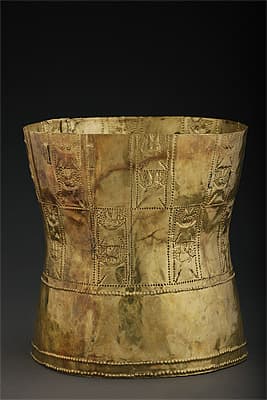SICÁN-LAMBAYEQUE culture North coast 750 – 1375 AD
Crown 750-1375 AD gold , rolling, embossing19.0 (h) cm 18.0 cm (diameter) Museo Oro del Perú, Lima Photograph: Daniel Giannoni
The cylindrical crown, with a slight waist, is made from a sheet of rolled gold fastened along the vertical seam with flat gold staples. The upper part has alternating panels of plain rectangles and images of two stylised birds with open bills and large round eyes. The birds fly upwards, one above the other. Boundaries are marked by punched dots, which are reiterated within the bird panels. The decorated area has a lower line of granulated balls, with another two similar lines circling the crown’s base.
For the headdress (cat. 115), metal was made to represent the form of feathers. Each is cut into shape from sheets of rolled gold, then fanned out in progressively greater curves. Three central plumes are flanked by four more on each side. Each feather is decorated at the base and tapers into a quill. Like other objects in the exhibition (cats 108–113, 116, 129), the headdress was found ‘in 1992 by the Proyecto Arqueológico Sicán of the eastern tomb at Huaca Loro, or Oro, at the Santuario Histórico de Pómac’.1 Traces of real feathers were bound into the headdress. Found in the same layer of a woven wicker chest was the crown ornament with six feline heads and curved triangular panache on a gold ball, which was made to rotate (cat.116).2 Placed on top of a layer of 14 gold discs, the headdress and ornament were among ‘a dozen gold, gold-silver and tumbaga tumi-shaped head ornaments and six sets of eleven or twelve large gold feathers’.3
Christine Dixon
1. Luisa María Vetter Parodi, cat. 256, in Paloma Carcedo de Mufarech (ed.), Inca: Origins and mysteries of the civilisation of gold, Venice: Marsilio 2010, p. 233.
2. Izumi Shimada, Jo-Ann Griffin and Adon Gordus, ‘The technology, iconography and social significance of metals’, in Colin McEwan, Precolumbian gold: Technology, style and iconography, London: British Museum Press 2000, p. 35.
3. Shimada et al., in McEwan, p. 35.
The cylindrical crown, with a slight waist, is made from a sheet of rolled gold fastened along the vertical seam with flat gold staples. The upper part has alternating panels of plain rectangles and images of two stylised birds with open bills and large round eyes. The birds fly upwards, one above the other. Boundaries are marked by punched dots, which are reiterated within the bird panels. The decorated area has a lower line of granulated balls, with another two similar lines circling the crown’s base.
For the headdress (cat. 115), metal was made to represent the form of feathers. Each is cut into shape from sheets of rolled gold, then fanned out in progressively greater curves. Three central plumes are flanked by four more on each side. Each feather is decorated at the base and tapers into a quill. Like other objects in the exhibition (cats 108–113, 116, 129), the headdress was found ‘in 1992 by the Proyecto Arqueológico Sicán of the eastern tomb at Huaca Loro, or Oro, at the Santuario Histórico de Pómac’.1 Traces of real feathers were bound into the headdress. Found in the same layer of a woven wicker chest was the crown ornament with six feline heads and curved triangular panache on a gold ball, which was made to rotate (cat.116).2 Placed on top of a layer of 14 gold discs, the headdress and ornament were among ‘a dozen gold, gold-silver and tumbaga tumi-shaped head ornaments and six sets of eleven or twelve large gold feathers’.3
Christine Dixon
1. Luisa María Vetter Parodi, cat. 256, in Paloma Carcedo de Mufarech (ed.), Inca: Origins and mysteries of the civilisation of gold, Venice: Marsilio 2010, p. 233.
2. Izumi Shimada, Jo-Ann Griffin and Adon Gordus, ‘The technology, iconography and social significance of metals’, in Colin McEwan, Precolumbian gold: Technology, style and iconography, London: British Museum Press 2000, p. 35.
3. Shimada et al., in McEwan, p. 35.
The cylindrical crown, with a slight waist, is made from a sheet of rolled gold fastened along the vertical seam with flat gold staples. The upper part has alternating panels of plain rectangles and images of two stylised birds with open bills and large round eyes. The birds fly upwards, one above the other. Boundaries are marked by punched dots, which are reiterated within the bird panels. The decorated area has a lower line of granulated balls, with another two similar lines circling the crown’s base.
For the headdress (cat. 115), metal was made to represent the form of feathers. Each is cut into shape from sheets of rolled gold, then fanned out in progressively greater curves. Three central plumes are flanked by four more on each side. Each feather is decorated at the base and tapers into a quill. Like other objects in the exhibition (cats 108–113, 116, 129), the headdress was found ‘in 1992 by the Proyecto Arqueológico Sicán of the eastern tomb at Huaca Loro, or Oro, at the Santuario Histórico de Pómac’.1 Traces of real feathers were bound into the headdress. Found in the same layer of a woven wicker chest was the crown ornament with six feline heads and curved triangular panache on a gold ball, which was made to rotate (cat.116).2 Placed on top of a layer of 14 gold discs, the headdress and ornament were among ‘a dozen gold, gold-silver and tumbaga tumi-shaped head ornaments and six sets of eleven or twelve large gold feathers’.3
Christine Dixon
1. Luisa María Vetter Parodi, cat. 256, in Paloma Carcedo de Mufarech (ed.), Inca: Origins and mysteries of the civilisation of gold, Venice: Marsilio 2010, p. 233.
2. Izumi Shimada, Jo-Ann Griffin and Adon Gordus, ‘The technology, iconography and social significance of metals’, in Colin McEwan, Precolumbian gold: Technology, style and iconography, London: British Museum Press 2000, p. 35.
3. Shimada et al., in McEwan, p. 35.


